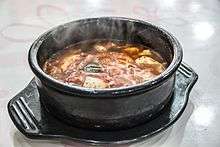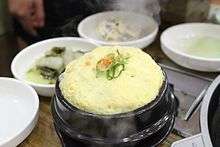Ttukbaegi
| Ttukbaegi | |
 Two jjigae (stew) served in ttukbaegi | |
| Hangul | 뚝배기 |
|---|---|
| Revised Romanization | ttukbaegi |
| McCune–Reischauer | ttukpaegi |
| IPA | [t͈uk̚.p͈ɛ̝.ɡi] |
A ttukbaegi (뚝배기) is a type of oji-gureut,[1] which is an onggi coated with brown-tone ash glaze.[2][3][4] The small, black to brown earthenware vessel is a cookware-cum-serveware used for various jjigae (stew), gukbap (soup with rice), or other boiled dishes in Korean cuisine. As a ttukbaegi retains heat and does not cool off as soon as removed from the stove, stews and soups in ttukbaegi usually arrive at the table at a bubbling boil.[5]
History
The Ttukbaegi dates from the Goryeo Dynasty, and has been widely used from the Joseon Dynasty up to the present day. In the Goryeo-period poem "This month", (이달충), the phrase "White-makgeolli is brought to the Ttukbaegi." Indicates the existence and common use of Ttukbaegi.[6]
Kinds
The ttukbaegi can be classified according to the production process and usage.
Classification according to production process
- Oji ttukbaegi(오지 뚝배기):The 'Oji' of the Oji bowl refers to the bowl of '오자기'(烏 瓷 器) which is grilled with a solid black color. The pottery with lye, which is a natural glaze, is already found in the Gaya period and early Silla period.[7]
- Jil ttukbaegi(질 뚝배기): The 'Jil ttukbaegi' is made like pots and pots, but they are not coated with lye. This ttukbaegi can be considered to be almost the same as the ancient earthenware process[8]
Idioms
As ttukbaegi is considered a crude pottery, people use the proverb "Soybean paste stew tastes better than a ttukbaegi looks. (Ttukbaegiboda jangmasi jota; 뚝배기보다 장맛이 좋다.)"[9] to say that you shouldn't prejudge the content by the humble outward appearance.[1]
Gallery
 Sundubu-jjigae served in ttukbaegi
Sundubu-jjigae served in ttukbaegi Kimchi-jjigae still boiling in ttukbaegi
Kimchi-jjigae still boiling in ttukbaegi Gyeran-jjim boiled and fluffed in ttukbaegi
Gyeran-jjim boiled and fluffed in ttukbaegi
See also
References
- 1 2 (in Korean) "ttukbaegi" 뚝배기 [stone pot]. Standard Korean Language Dictionary. National Institute of Korean Language. Retrieved 1 March 2017.
- ↑ Suh, Cheong-Soo; Rowan, Bernard; Cho, Yoon-jung, eds. (2004). An Encyclopaedia of Korean Culture (English ed.). Seoul: Hansebon. p. 41. ISBN 9788995135242.
- ↑ Lee, Jin-hyuk; Mouat, Colin A. (2014). Korean Handicrafts: Art in Everyday Life. Seoul: Seoul Selection. ISBN 9788997639540.
- ↑ Kim, Yong-ho; Lee, Yu jin (2014). "A study on the chronology of Joseon period 'onggi' found in mid-western area" (PDF). Archaeological Studies of Science and Technology. Ajou University Museum of Tools. 20: 109.
- ↑ Pettid, Michael J. (2008). Korean Cuisine: An Illustrated History. London: Reaktion Books. p. 57. ISBN 978-1-86189-348-2.
- ↑ (사)한국전통주진흥협회.
- ↑ "오지그릇 - 한국민족문화대백과사전". encykorea.aks.ac.kr (in Korean). Retrieved 2018-04-07.
- ↑ "e뮤지엄".
- ↑ Koehler, Robert (2010). Lee, Jin-hyuk; Mouat, Colin A. Mouat, eds. Traditional Food: A Taste of Korean Life. Seoul: Seoul Selection. ISBN 9788991913769.
External links

- What Is A Sous Vide Cooking?

